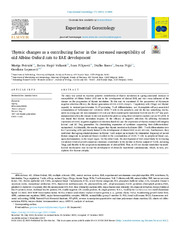Приказ основних података о документу
Thymic changes as a contributing factor in the increased susceptibility of old Albino Oxford rats to EAE development
| dc.creator | Petrušić, Marija | |
| dc.creator | Stojić-Vukanić, Zorica | |
| dc.creator | Pilipović, Ivan | |
| dc.creator | Kosec, Duško | |
| dc.creator | Prijić, Ivana | |
| dc.creator | Leposavić, Gordana | |
| dc.date.accessioned | 2022-11-22T14:33:24Z | |
| dc.date.available | 2022-11-22T14:33:24Z | |
| dc.date.issued | 2023 | |
| dc.identifier.issn | 0531-5565 | |
| dc.identifier.uri | https://farfar.pharmacy.bg.ac.rs/handle/123456789/4316 | |
| dc.description.abstract | The study was aimed to examine putative contribution of thymic involution to ageing-associated increase in susceptibility of Albino Oxford (AO) rats to the development of clinical EAE, and vice versa influence of the disease on the progression of thymic involution. To this end we examined (i) the parameters of thymocyte negative selection efficacy, the thymic generation of CD4+CD25+Foxp3+ T regulatory cells (Tregs) and thymic capacity to instruct/predetermine IL-17-producing T-cell differentiation, and thymopietic efficacy-associated accumulation of “inflammescent” cytotoxic CD28- T cells in the periphery, and (ii) the key underlying mechanisms in young and old non-immunised AO rats and their counterparts immunised for EAE (on the 16th day post-immunisation when the disease in old rats reached the plateau) using flow cytometry analysis and/or RT-qPCR. It was found that thymic involution impairs: (i) the efficacy of negative selection (by affecting thymocyte expression of CD90, negative regulator of selection threshold and the expression of thymic stromal cell integrity factors) and (ii) Treg generation (by diminishing expression of cytokines supporting their differentiation/maturation). Additionally, the results suggest that thymic involution facilitates CD8+ T-cell differentiation into IL-17-producing cells (previously linked to the development of clinical EAE in old AO rats). Furthermore, they confirmed that ageing-related decrease in thymic T-cell output (as indicated by diminished frequency of recent thymic emigrants in peripheral blood) resulted in the accumulation of CD28- T cells in peripheral blood and, upon immunisation, in the target organ. On the other hand, the development of EAE (most likely by increasing circulatory levels of proinflammatory cytokines) contributed to the decline in thymic output of T cells, including Tregs, and thereby to the progression/maintenance of clinical EAE. Thus, in AO rats thymic involution via multi-layered mechanisms may favour the development of clinically manifested autoimmunity, which, in turn, precipitates the thymus atrophy. | |
| dc.publisher | Elsevier Inc. | |
| dc.relation | info:eu-repo/grantAgreement/MESTD/inst-2020/200161/RS// | |
| dc.relation | info:eu-repo/grantAgreement/MESTD/inst-2020/200177/RS// | |
| dc.rights | openAccess | |
| dc.rights.uri | https://creativecommons.org/licenses/by-nc-nd/4.0/ | |
| dc.source | Experimental Gerontology | |
| dc.subject | Ageing | |
| dc.subject | CD28- T cells | |
| dc.subject | EAE susceptibility | |
| dc.subject | Natural Treg | |
| dc.subject | Tc17 cell thymic generation | |
| dc.subject | Thymic atrophy | |
| dc.title | Thymic changes as a contributing factor in the increased susceptibility of old Albino Oxford rats to EAE development | |
| dc.type | article | |
| dc.rights.license | BY-NC-ND | |
| dc.citation.volume | 171 | |
| dc.citation.rank | M22~ | |
| dc.identifier.wos | 000890488300009 | |
| dc.identifier.doi | 10.1016/j.exger.2022.112009 | |
| dc.identifier.pmid | 36334894 | |
| dc.identifier.scopus | 2-s2.0-85141678802 | |
| dc.identifier.fulltext | http://farfar.pharmacy.bg.ac.rs/bitstream/id/10839/Thymic_changes_as_pub_2023.pdf | |
| dc.type.version | publishedVersion |

